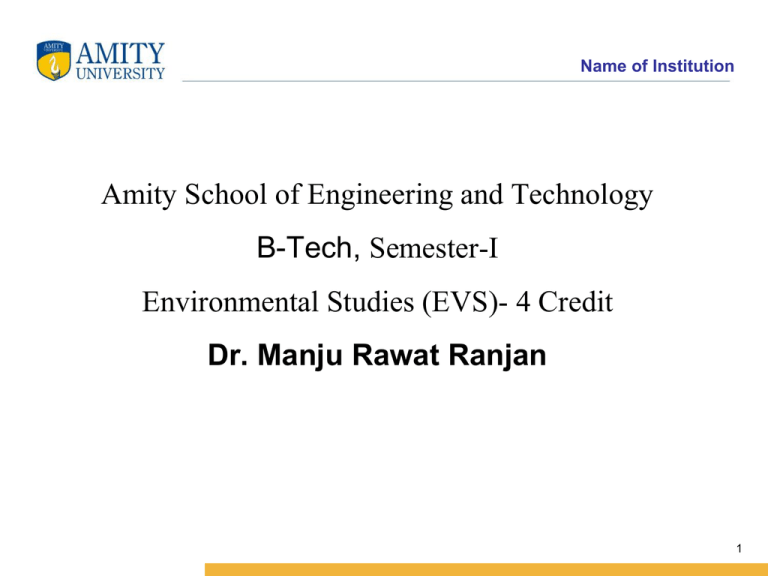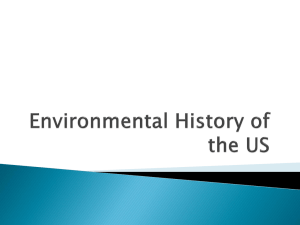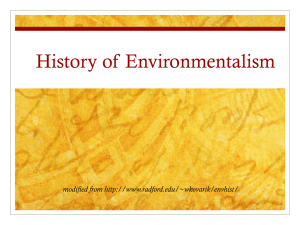Environmental Studies
advertisement

Name of Institution Amity School of Engineering and Technology B-Tech, Semester-I Environmental Studies (EVS)- 4 Credit Dr. Manju Rawat Ranjan 1 Course Modules Total 7 Modules The Multidisciplinary Nature of Environmental Studies ( Scope and importance) Natural Resources (Type, Use, problem and suggested measure) Ecosystem (concept, structure and function, type) Bio-diversity and its Conservation Environmental Pollution (Type, causes, effect and remedies) Social Issue and the Environment Human Population and Environment The Multidisciplinary Nature of Environmental Studies (Scope and importance) Environment: Environment is French word “Environner”, which mean to encircle or surround. That is all the physical and biological surroundings of an organism along with their interactions such as atmosphere, hydrosphere and lithosphere, which surround us is known as our environment. Environment Abiotic Air Water Biotic Soil Material Plant Animal Microbes Interaction occur between abiotic and biotic component, such as transfer of material and energy. Air, water and land, which surround us influence us and we influence it by overuse or over exploitation of resources and also by discharge of pollutants. The impact is bi-directional, the interaction could be directly and indirectly. Environmental Studies Study of our environment which include both physical and biological component, interaction among its component, effect of these component on human being and vice versa. However, we can not study Environment in isolation, environmental studies also had input from various other discipline of sciences, engineering, social science, Law, governance. The multidisciplinary nature of environmental science is illustrated in following diagram Life Science (Biology, biochemistry, Microbiology etc) Modeling Mathematics, Statistics, Computer science Basic and Applied Studies Physical Science, (physics, chemistry, Earth science, Atmospheric Science) Environmental Studies Technology Civil, Chemical, Hydraulics ,Nano Management and Awareness Economics, Sociology, Law, Education, Management, Mass communication Scope of Environmental Studies: Environmental Studies encompasses large number of areas which mainly include: Natural Resource- Conservation and Management Ecology and Biodiversity Environment Pollution and Control Economic development and associate socio-cultural issues Human population and environment. It can also include highly specialized issues like Environmental Science, Environmental Engineering and Environmental Management This subject had a wide field of applicationResearch and Development: include research and development of pollution control technology, clean fuel development, sustainable agricultural practice, carbon credit Green advocacy: Increase emphasis on implementation of various acts and laws resulted in environmental lawyers, who could enforced pollution, wildlife, forest protection related laws. Green marketing : more emphasis on consumer good which are more eco-friendly, Food products without contamination of pesticides, insecticides. Increase use of products with ECO marks. Green media: Mass media which include print media and electronic media are Important means of spreading awareness about environment pollution and conservation. Importance of Environment studies: Environmental studies have become significant for the following reason: Environment Issues being of International Importance: environmental issues such as global warming, ozone depletion, biodiversity loss, marine pollution etc have a global implication. Problems Cropped in The Wake of Development : rapid development in the Selected area leads to Urbanization, Industrial Growth, Transportation Systems, Agriculture and Housing etc which in turn leads to environmental pollution. Rapid increase in Population: rapid growth of human population resulted into tremendous increase in the demand of resources such as food resources, energy resources ultimately leading to the environmental degradation. Need for An Alternative Solution: recently their is a sense of feeling that current way of economic development is not feasible for long term as resources base is not unlimited giving rise to the concept of sustainable development. Need To Save Humanity From Extinction: There is a grave threat on humanity due to continuous degradation of its resource base which has implication on survival and well being of human society. Need for public Awareness: International efforts for environment: The subject of environment come into international focus first with the Stockholm Conference held on 5th 1972, since then we celebrate World Environment Day on 5th June. It further got attention with the Earth Summit took place in Rio de Janeiro in 1992. In this summit Agenda 21- a global agenda for transition to sustainability in the 21st century. Beside that many International treaty and protocol are done to safeguard environment: Montreal Protocol on Substances: That Deplete the Ozone Layer, Montreal, 1989 Kyoto protocol: adopted in 1997, come in force in 2005. Establishment of The Intergovernmental Panel on Climate Change (IPCC) in 1988 by the World Meteorological Organization (WMO) and the United Nations Environment Programme (UNEP) in recognition of the problem of global warming. Nobel peace prize in 2004 to Ms. Wangari Maathai (Green Belt Movement) and Jointly to IPCC and Albert Arnold (Al) Gore Jr. in year 2007 also highlight the importance of environment. Public Awareness for Environment: Without active people participation government cant force any policy so to make public aware regarding environmental pollution and its conservation. This awareness can be achieved by various mean: Formal Environmental education: at School level, University and post-graduation level, Higher research Non-formal education and awareness Program: • National Environment Awareness Campaign (NEAC)- Started in 1986 is a multimedia campaign which uses activities such as seminar, workshops, camps, exhibitions, debate, street theatre, tree plantation to promote awareness about environment. • Eco Clubs of National Green Corps: Target audience are school student, 50,000 eco clubs are set up till now, Govt. provide training and resources. • Mass Awareness: Through media including both print and electronic media. Campaign for banning plastic Product, clean Yamuna campaign. Awareness activities by NGO’s and other institutions on the occasion of Environment days like Earth day. • Eco Mark: Eco-labelling of consumer products as Ecomark in 1991. It is an earthen pitcher and awarded to product that is made, used or disposed off in eco-friendly manner. Contemporary Indian Environmentalists: Environmental ethos are always part of ancient Indian civilization as The Jain, Vedic and Buddhist traditions established the principles of ecological harmony centuries ago. The first instances of environmental movement was observed in year 1730, where 363 Bishnois, led by Amrita Devi sacrificed their lives while protecting green Khejiri trees considered sacred by the community, by hugging to them, this incident is the first event of Chipko movement in the recorded history. Government of India started Amrita Devi Bishnoi Wildlife Protection Award for respecting her effort. Other environmental activist like Sunderlal Bahuguna, known for his Chipko movement and Tehri Bachao Andolan, Smt. Medha Patkar and Ms. Arundhati Roy for Narmada Bachao Andolan, Magsaysay awarded Rajender Singh known for his water conservation effort. Green Judge Justice Kuldeep Singh and Green advocate Sh. M.C.Mehta are Environmental lawyers. Present IPCC chairman Mr.R.K.Pachuri of TERI and late Sh. Anil Aggrawal the founder chairman of Centre for Science and Environment (CSE) are also known for their scientific wisdom.











